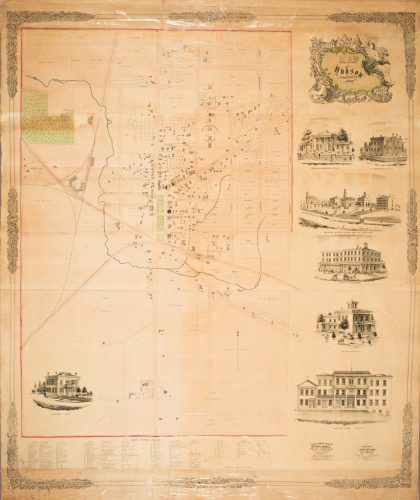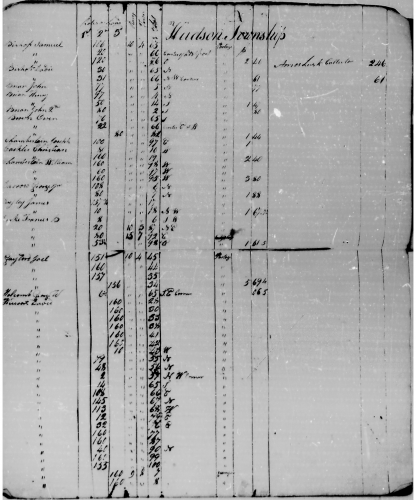The Hudson Library retains a wide variety of materials to assist you in learning more about the history of your home. Archives librarians are also available to help you get your started on your house research. Please contact us for more information.
Start here
If you are just looking for basic information on your home, we suggest you start with the following resources first:
Discover the history of Hudson’s oldest homes and buildings. This table includes many of the city’s oldest homes and incorporates data from the library’s Summit Memory Collections and Hudson Heritage Association. Details for homes may include architectural information, house reports (if available), house history and links to related collections. Photographs, if available, were created by William Moos (1919-1984) who was a painter, architect and founding member of the Hudson Heritage Association.
This book is a photographic and written catalog of 350 structures in Hudson and is a good place to start for basic information. Copies of the book are available for circulation.
The Hudson Library maintains a collection of The Hudson Heritage Association house reports, which vary in size and scope but typically include genealogy of previous owners, deed and tax history, architectural reports/ inspections and occasional photographs.
The Hudson Library’s Houses of Hudson Collection in Summit Memory includes photographs and descriptions for more than 500 homes in the downtown Hudson corridor, keyword searchable by address. This resource includes basic descriptions of properties sometimes including homeowner information and approximate build date.
Located in the archives reading room. The city directories are helpful for tracking down property owners. Some of the city directories (1910, 1950) list properties by address, rather than by owner, which makes the searching easier.
It is recommended to start working at the latest possible date and work backwards in time. If you are interested in conducting more extensive house research, please consult the tips below.
GREAT LOT/SUBLOT
To start house research, it is recommended that you know the great lot and sublot (or village block) (if applicable) where the house once stood (or still stands). Land in Western Reserve was originally divided into evenly divided townships and ranges and then further subdivided into great lots. Hudson (known as Range 10, town 4) consisted of 100 great lots (see image). Maps are the best resource for determining the great lot and sublot numbers.

Located in the archives reading room dating 1855, 1878 and 1891.
Located in the archives reading room, but also available online through Summit Memory:
Additional atlases located in the archives reading room and available online
- Atlas of Athens County, Ohio, 1875
- The centennial atlas of Athens County, Ohio, 1903
- Atlas of Cuyahoga county, Ohio, from actual surveys, 1874
- History of Geauga and Lake Counties, Ohio with Illustrations and Biographical Sketches of its Pioneers and Most Prominent Men, 1878
- Caldwell’s atlas of Harrison County, Ohio: from actual surveys, 1875
- The Standard Atlas of Holmes County, Ohio, 1907
- Atlas of Muskingum Co., Ohio, 1866
- Combination Atlas Map of Stark County, Ohio, 1875
- Combination atlas map of Tuscarawas County, Ohio, 1875
- Digital Ohio County Atlases
- Library of Congress Digitized Maps
- The Public Library of Cincinnati & Hamilton County
- Ohio History Connection Historic Atlases
It is useful to know if the property you are searching for is in the TOWNSHIP or VILLAGE of Hudson.
| TOWNSHIP | VILLAGE | |
|---|---|---|
| Great Lot Numbers | 35, 36, 45, 46, 55, 56, 65, 66 | Usually any other great lot |
| Subdivision | Usually subdivided even further (great lot | block | sublot) | Typically not subdivided further (formerly) but usually given a directional location within the sublot (i.e. 60 North or 60 N) |
Deed Research
Deeds provide information about the ownership of the history of a property. You should be familiar with the terms “grantor” and “grantee” when doing property research. A Grantor (“Seller”) is the individual who transfers the property to the Grantee (“Buyer”). Deeds will only give you information about who owned the property, but will typically not include information about improvements or additions (buildings) added to the land.
This resource is available in the Hudson Library archives. You must know a grantor/grantee (either from general knowledge, tax records or maps) to at least get started. Start by using the index in the back of the volume to find the pages where the individual is listed.
Deeds are maintained at the county level. Hudson was part of three different counties throughout its history: Trumbull (1799-1807), Portage (1807-1840), Summit (March 3, 1840-present). The Summit County Recorder’s office has the full run of deeds, but other county offices may be consulted below:
Tax Research
Tax records are helpful to determine home construction dates and ownership history. Once you know either the home owner (during a particular year) or the great lot number, you can start working on the tax research.

The Hudson Library owns microfiche copies of the tax auditor’s records from 1808-1939.
The Summit County Fiscal Office has original copies of all tax records to present.
Additional Resources
These are detailed maps of U.S. cities and towns in the 19th and 20th centuries. Then can be helpful to track ownership of buildings from one year to the next, and also when lots were developed into buildings and houses.
Trace the owner of a property using census records. Keep in mind that the 1890 census was destroyed in a fire and does not exist.
- Ancestry Library Edition (available for free at the Hudson Library & Historical Society)
- U. S. Census records; military records; court, land and probate records; vital and church records; directories; petitions for naturalization; passenger lists and more.
- Family Search
- Offers free family history, family tree and genealogy records and resources from around the world. The site features an online searchable database of many different records including the United States Census and the U.S. Social Security Death Index as well as military, church, and vital records from the United States and from many different countries.
Keep all of your research organized with this worksheet.
View the Hudson Library’s Genealogy Resources page for more information on available resources.
